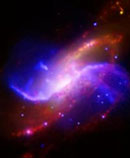|
by Global Good News staff writer
26 December 2007
Excerpted with permission from the Introduction by Tom
Egenes to the Eternal Stories from the Upanishads
The Upanishads contain beautiful and exhilarating
phrases such as 'Thou art That.' (Tat tvam asi), 'I am
Totality' (Aham Brahmasmi), and 'All this is Brahman —
Totality.' (Sarvam khalv idam Brahma). These phrases
are nothing less than descriptions of the supreme
awakening of consciousness to its own true nature.
They are known as 'great sayings' (mahavakya) because
they describe the essential teaching of the Upanishads
in compact expressions.
Maharishi describes these sayings as the final strokes of knowledge from the teacher, which fully enlighten the student who is ready to receive them; then Wholeness dawns in the awareness. In reading the stories from the Upanishads, we are thus reminded of the flow of our life towards its supreme goal.
The Upanishads especially focus on the ultimate
reality of life; they express the full glory of the Self, Atma, by gaining which nothing else is left to be gained. The Upanishads bring out that the true nature of the Self is wholeness, the totality of Natural Law, Brahman.
This is beautifully exemplified in The Story of King Ashvapati and the Universal Self from the Chhandogya Upanishad in which six blind men hold scholarly debates among themselves about the true nature of an elephant:
'An elephant is small, like a rope,' one blind man
would say.
'No, an elephant is big, like a wall,' another would
answer.
'An elephant is round, like a tree.'
'No, an elephant is flat like a piece of cloth.'
'An elephant is hard like a conch shell.'
'No, an elephant is soft like rubber.'
Each considered his own description to be true and
could not understand how a seemingly opposite
description could also be true. Then along came a man
who could see. He explained that the elephant was all
of these together. He said:
'Now of this elephant, the tail is small, like a rope; the body is big, like a wall; the legs are round, like trees; the ears are flat, like pieces of cloth; the tusks are hard like conch shells; and the trunk is soft, like rubber.'
'Each blind man knew only part of the whole,' said
the King. 'Like this, the Self is Wholeness. The Self
is universal. When you truly know the Self, then you
know everything.'
Satya Loka, the realm of Truth, and dwelling place of
Lord Brahma, is so called because all who lived there
knew the eternal truth of existence within themselves.
In this place, siddhas, perfected beings, enjoyed
peace and harmony. Here, anyone who asked received the essence of all knowledge, Brahma Vidya:
Aham vishvam idam vichitram
I am this wonderful universe.
Copyright © 2007 Global Good News(sm) Service
|


